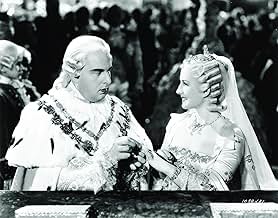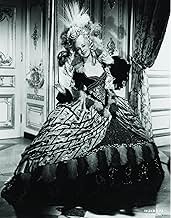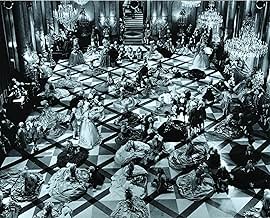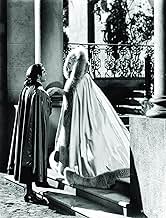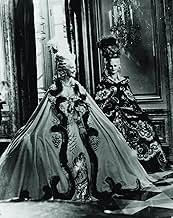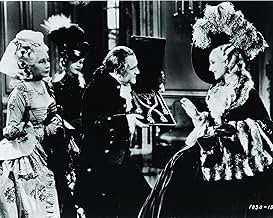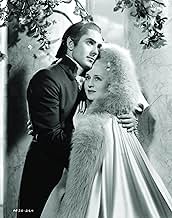NOTE IMDb
7,3/10
3,5 k
MA NOTE
Ajouter une intrigue dans votre langueThe tragic life of Marie Antoinette, who became queen of France in her late teens.The tragic life of Marie Antoinette, who became queen of France in her late teens.The tragic life of Marie Antoinette, who became queen of France in her late teens.
- Réalisation
- Scénario
- Casting principal
- Nommé pour 4 Oscars
- 5 victoires et 5 nominations au total
Albert Dekker
- Comte de Provence
- (as Albert Van Dekker)
Avis à la une
This movie will probably never be excelled largely because of the casting. I don't believe that anyone will ever find better actors or actresses to portray King Louis XVI and Queen Marie Antoinette than Robert Morley and Norma Shearer. The black and white aspect of this great classic film is simply spell binding in its interpretation of the life of the Royal Family. Color will give it a different dimension. The manner in which the conflict of the ensuing mob marching upon the Versailles is well portrayed. I especially like the sense of paranoia and fear that grip the Queen and her entourage. The use of the outside gate is especially endearing to me, reminding me why it is that King Louis XIV created the Château d' Versailles in such a distance from Paris. Unless one knows the history of the Château, nobody can truly appreciate the march of the Faubourgs. Excellent film, and I recommend seeing it before any other on the same subject!
As a young actress still in her 20s, Norma Shearer was hailed as the First Lady of MGM, and she reigned as queen of the studio throughout the 1930s. For about two decades after early retiring in 1942, she was fondly remembered by fans and critics, but slowly she was mostly forgotten. Then in the early 70s, antagonistic film critic Pauline Kael, grudge-holding MGM rival Joan Crawford and others took delight in trashing her, usually with the implication that Norma's greatest talent was finding a powerful husband (Irving Thalberg). Unfortunately, those unfair remarks carried great weight since Shearer's movies were unavailable on video and rarely shown on TV.
We're now able to see her talent for ourselves, thanks largely to Turner Classic Movies, and Norma Shearer's star is rising again.
If you've never seen a Shearer movie, Marie Antoinette is a good beginning. It is one of Hollywood's great epics of the 1930s, with lavish costumes and scenery, and its historic setting holds up well. Shearer plays the doomed French queen from teenager to the Guillotine, and the final scenes as she awaits death in prison are among the finest of her career.
In recent years, Shearer has gained new respect for her silent and pre-code films, in which she was one of the most accomplished young actresses of the era. She often played sexually sophisticated women with a sly wit. She was not a typical ingénue, and you can see why audiences of the time were enchanted by her.
We're now able to see her talent for ourselves, thanks largely to Turner Classic Movies, and Norma Shearer's star is rising again.
If you've never seen a Shearer movie, Marie Antoinette is a good beginning. It is one of Hollywood's great epics of the 1930s, with lavish costumes and scenery, and its historic setting holds up well. Shearer plays the doomed French queen from teenager to the Guillotine, and the final scenes as she awaits death in prison are among the finest of her career.
In recent years, Shearer has gained new respect for her silent and pre-code films, in which she was one of the most accomplished young actresses of the era. She often played sexually sophisticated women with a sly wit. She was not a typical ingénue, and you can see why audiences of the time were enchanted by her.
This is a fantastic movie, a real emotional roller coaster, one feels emotionally exhausted at the end, the last 20mins are truly harrowing. How Norma Shearer didn't win the academy award for best actress is beyond me. Other great performances include the debut of Robert Morley and the incredible acting of Joseph Schildkraut, the makeup he wears must have been truely scandalous at the time. The costumes are spectacular you really are taken back to the late 1770's. another point of note is how Norma Shearer ages in the film is incredible, from the young girl in the beginning to the much older broken woman at the end, very well done indeed. Tyrone Power is very good as well, one can go on for ages about Marie Antoinette, it truly is a spectacle in the grand MGM scale. 8 1/2 out of 10!
A legend in France tells that Julien Duvivier was involved in this film;if he really did something,it was probably minimal;an educated man like him would have been scared by the numerous historical errors of the film.
Here are some of them: -Never Louis XV spoke of sending the dauphine back to where she once belonged,in Austria.The quarrel with Madame du Barry is pure fiction:M.A. spoke once to the favorite ,she said " There are many people here today in Versailles."She never addressed her afterward.
-Louis XVI was not the moron we see in the film.He was actually an educated man.When he was in jail,he would teach his son maths,history ,geography and other subjects.He was not made to be king,that's true ,and all that follows Louis XV 's death is accurate .He reportedly said to his distraught wife :"What a misfortune,we're too young to reign!".He used to go hunting (his favorite pastime) but he was not the half-wit depicted in Van Dyke's film.
-The Royal family was not imprisoned in Le Temple just after the night of Varennes.That escape took place on the 20th of June 1791.The storming of the Tuileries (not included in the movie for a good reason)happened on August ,the 10th 1792;the fall of the monarchy and the Republic followed in September the same year.
-But the queen's last night takes the biscuit!Fersen in her dungeon,no less!
Forget history,and you have a wonderful show,a novel based on M.A.'s life.There are many remarkable things all along the viewing: M.A. in the corridors of her palace,in Vienna ,where her mother tells her "You shall be queen of France" . The sentence will come back ,quite rightly so,in the last pictures.
The affair of the necklace,told in admirable succinct style;the scene when the queen learns that the cardinal de Rohan is free ,while arriving at the opera theater,is a great dramatic idea.
The longest night of June,which tragically ended in Varenne is given an adequate dark treatment where only the torches lighten the forest or the village.
The scene which climaxes the movie is the Royal family's last supper.Here Robert Morley transcends the limitation he is working under ,and makes Louis XVI a clever sensitive man :the rapport he has with his child was obvious in real life and all rings true.The broken soldier's story will intensely move you.Besides ,it was a good idea to film M.A.'s and the dauphin's separation just after the king's death (actually ,the king died on the 21th of January 1793,and M.A. was separated from her child in the following Summer) cause it increases tenfold the queen's tragedy.This scene lasted one hour!one hour! When she left LE Temple for la Conciergerie (where you can visit her dungeon today),the queen said:"Nothing can hurt me now."
Here are some of them: -Never Louis XV spoke of sending the dauphine back to where she once belonged,in Austria.The quarrel with Madame du Barry is pure fiction:M.A. spoke once to the favorite ,she said " There are many people here today in Versailles."She never addressed her afterward.
-Louis XVI was not the moron we see in the film.He was actually an educated man.When he was in jail,he would teach his son maths,history ,geography and other subjects.He was not made to be king,that's true ,and all that follows Louis XV 's death is accurate .He reportedly said to his distraught wife :"What a misfortune,we're too young to reign!".He used to go hunting (his favorite pastime) but he was not the half-wit depicted in Van Dyke's film.
-The Royal family was not imprisoned in Le Temple just after the night of Varennes.That escape took place on the 20th of June 1791.The storming of the Tuileries (not included in the movie for a good reason)happened on August ,the 10th 1792;the fall of the monarchy and the Republic followed in September the same year.
-But the queen's last night takes the biscuit!Fersen in her dungeon,no less!
Forget history,and you have a wonderful show,a novel based on M.A.'s life.There are many remarkable things all along the viewing: M.A. in the corridors of her palace,in Vienna ,where her mother tells her "You shall be queen of France" . The sentence will come back ,quite rightly so,in the last pictures.
The affair of the necklace,told in admirable succinct style;the scene when the queen learns that the cardinal de Rohan is free ,while arriving at the opera theater,is a great dramatic idea.
The longest night of June,which tragically ended in Varenne is given an adequate dark treatment where only the torches lighten the forest or the village.
The scene which climaxes the movie is the Royal family's last supper.Here Robert Morley transcends the limitation he is working under ,and makes Louis XVI a clever sensitive man :the rapport he has with his child was obvious in real life and all rings true.The broken soldier's story will intensely move you.Besides ,it was a good idea to film M.A.'s and the dauphin's separation just after the king's death (actually ,the king died on the 21th of January 1793,and M.A. was separated from her child in the following Summer) cause it increases tenfold the queen's tragedy.This scene lasted one hour!one hour! When she left LE Temple for la Conciergerie (where you can visit her dungeon today),the queen said:"Nothing can hurt me now."
It never ceases to amaze me at how completely I might be suddenly drawn into the emotional moment of a film by the power of the actor. Usually the strongest ones come suddenly, and without warning, giving you no time to put up defenses. Brando's eruptions of moods when talking to his dead wife in Last Tango in Paris is probably the most dramatic example of this. (His greatest scene ever, that I have witnessed) But before that, Norma Shearer's panic and utter emotional breakdown when the guards come to take her son from her in the prison, is overwhelming and complete. Anyone who is not genuinely moved to the core by this incredible performance, either sleeps or does not possess those human sensitivities that are torn by the loss of a child. For it is not sympathy that is evoked, but an empathy called forth by the raw, human agony of the suffering before you. Years later when I visited the actual site in Paris where that tragedy would have taken place, I experienced a time of respect and reflection such as I have never had in any other place in the world that I have visited.
This is one of the truly great films. If you want to find out how deeply someone can feel, show it to them and observe. Norma Shearer set a standard I fear has been forgotten, as evidenced by the way tinsel town hands out awards today for mediocre work pushed onto the modern consciousness by glitzy ad campaigns and self-serving accolades.
This is one of the truly great films. If you want to find out how deeply someone can feel, show it to them and observe. Norma Shearer set a standard I fear has been forgotten, as evidenced by the way tinsel town hands out awards today for mediocre work pushed onto the modern consciousness by glitzy ad campaigns and self-serving accolades.
Le saviez-vous
- AnecdotesAccording to Wikipedia, the movie had thousands of costumes and lavish set designs. Adrian visited France and Austria in 1937 researching the period. He studied the paintings of Marie Antoinette, even using a microscope on them so that the embroidery and fabric could be identical. Fabrics were specially woven and embroidered with stitches sometimes too fine to be seen with the naked eye. The attention to detail was extreme, from the framework to hair. Some gowns became extremely heavy due to the embroidery, flounces and precious stones used. Norma Shearer's gowns alone had a combined weight of over 1,768 lb., the heaviest being the wedding dress.
- GaffesAt the time of their wedding, the Dauphin, Louis, was 15 and Marie Antoinette was 14. Norma Shearer could (barely) get away with portraying a 14-year-old (as she portrayed a 13-year-old Juliet in ROMEO AND JULIET (1936) because many noble/royal females were more mature and had regal bearing), but Robert Morley looked 35, not 15.
- Citations
Marie Antoinette: I once thought if I were queen, I'd be so happy. To be applauded and adored and obeyed. I don't want it now. I just want to be free. To be with you. To love you. I cannot wear a crown upon my heart.
- Versions alternatives"Unrestored" film has now been restored and is available on DVD. When the film played the Carthay Circle in Los Angeles and the Astor Theatre in New York as a reserved seat "road show" attraction, the print ran eleven minutes longer than the generally available 149 minute Turner Library print. These eleven minutes contained an overture, entr'acte, and exit music, with an intermission immediately following Antoinette's emotional farewell to Fersen on the steps of Versailles. These remnants of the "road show" presentation have now been restored to the new Warner Bros. Home Video DVD, which runs a little over 157 minutes.
- ConnexionsEdited into Hollywood: The Dream Factory (1972)
Meilleurs choix
Connectez-vous pour évaluer et suivre la liste de favoris afin de recevoir des recommandations personnalisées
- How long is Marie Antoinette?Alimenté par Alexa
Détails
Box-office
- Budget
- 2 926 000 $US (estimé)
- Durée
- 2h 29min(149 min)
- Rapport de forme
- 1.37 : 1
Contribuer à cette page
Suggérer une modification ou ajouter du contenu manquant


